Tactical Home Defense: Defensive Positioning
Tactical Home Defense & Security: Defensive Positioning
Our Tactical Home Defense and Security training course goes into detail on a wide range of topics relating to home defense while providing examples of effective tactics and techniques that can help you protect yourself and your family.
This short article covers a few sections and diagrams from the section on armed defense techniques when an intruder is in your home (or place of business). The full training goes into much more detail on these topics and also covers many other critical topics including community defense planning, threat assessment, improvised weapons and security systems.
This short article covers a few sections and diagrams from the section on armed defense techniques when an intruder is in your home (or place of business). The full training goes into much more detail on these topics and also covers many other critical topics including community defense planning, threat assessment, improvised weapons and security systems.
Hiding in the Corner vs. Maintaining Longer Sightlines
Many people believe that the best way to defend against an intruder is to hide in the corner of a room and wait for the intruder to walk through the door. While this is an option and offers some advantages in certain situations, there are several reasons why it is often not preferable.
Write your awesome label here.
Tactical Home Defense Training Course
This course adapts combat-tested military principles and tactics to the mission of civilian home defense & security. The concepts and techniques presented can also apply to a wide range of situations and threat environments.
First, by the time the intruder turns the corner, he will already be at close range and will likely be able to get a few shots off even if you succeed in shooting him. Historical examples of such close-range gun fights generally result in multiple bullets flying each way before one or both of the shooters goes down.
Second, when hiding in a corner, unless you specifically move heavy furniture in front of you, you will probably be exposed and have less cover/concealment. You will also be stuck in one place with little ability to maneuver, and may be further limited in your ability to monitor your surroundings and maintain your situational awareness.
It is therefore preferable to identify covered and concealed positions with longer sightlines that allow you to engage intruders at greater range. It is also important to remember that many intruders might run away if shots are fired on them from an unknown position. Therefore, rather than forcing the intruder into a desperate, close-quarters shootout, it might be better to engage at range, increasing the likelihood that he will run away or at the very least delay his advance.
In the illustration below, notice the positions and sightlines of the defending occupants. The dotted green lines provide some examples of locations with more advantageous longer sightlines within the house, while the red lines provide examples of shorter sight lines offered by defensive corner positions within the same house. As you can see, the longer sightlines offer much greater situational awareness, visibility, and engagement stand-off distance over the "hiding in a corner" tactic.
Second, when hiding in a corner, unless you specifically move heavy furniture in front of you, you will probably be exposed and have less cover/concealment. You will also be stuck in one place with little ability to maneuver, and may be further limited in your ability to monitor your surroundings and maintain your situational awareness.
It is therefore preferable to identify covered and concealed positions with longer sightlines that allow you to engage intruders at greater range. It is also important to remember that many intruders might run away if shots are fired on them from an unknown position. Therefore, rather than forcing the intruder into a desperate, close-quarters shootout, it might be better to engage at range, increasing the likelihood that he will run away or at the very least delay his advance.
In the illustration below, notice the positions and sightlines of the defending occupants. The dotted green lines provide some examples of locations with more advantageous longer sightlines within the house, while the red lines provide examples of shorter sight lines offered by defensive corner positions within the same house. As you can see, the longer sightlines offer much greater situational awareness, visibility, and engagement stand-off distance over the "hiding in a corner" tactic.
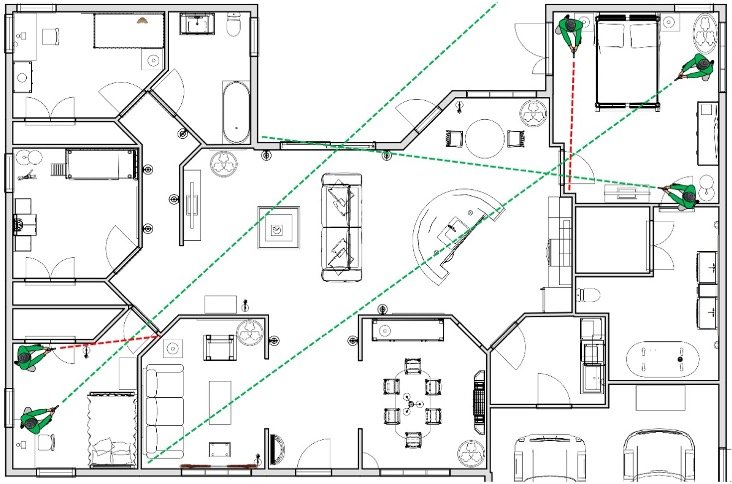
Successive Fall Back Positions
By engaging intruders at greater range, you increase your own mobility and situational awareness. You then also have the ability to fall back to successive defensive positions as threats advance towards you.
Identify good covered and concealed positions that offer sightlines along likely threat avenues of approach. With the help of your senses, identify which direction intruders are coming from, move to your first defensive position, and engage the intruders.
Remain alert for intruders coming from other directions or trying to flank around and surprise you from behind. As intruders approach, fall back to your next defensive position. In some cases, you may want to fire a few shots to suppress the intruders before falling back. If you are operating with a partner, your partner can provide cover as you fall back. By falling back in this way, you offer yourself multiple opportunities to engage the intruders from behind cover or concealment, making it more likely that they will run away and/or buying you and your family time to escape.
The diagram below gives a generalized example of how you might establish multiple defensive fall back positions. Consider the layout of your home (or place of business) and what defensive fallback positions you might employ, if necessary.
Identify good covered and concealed positions that offer sightlines along likely threat avenues of approach. With the help of your senses, identify which direction intruders are coming from, move to your first defensive position, and engage the intruders.
Remain alert for intruders coming from other directions or trying to flank around and surprise you from behind. As intruders approach, fall back to your next defensive position. In some cases, you may want to fire a few shots to suppress the intruders before falling back. If you are operating with a partner, your partner can provide cover as you fall back. By falling back in this way, you offer yourself multiple opportunities to engage the intruders from behind cover or concealment, making it more likely that they will run away and/or buying you and your family time to escape.
The diagram below gives a generalized example of how you might establish multiple defensive fall back positions. Consider the layout of your home (or place of business) and what defensive fallback positions you might employ, if necessary.
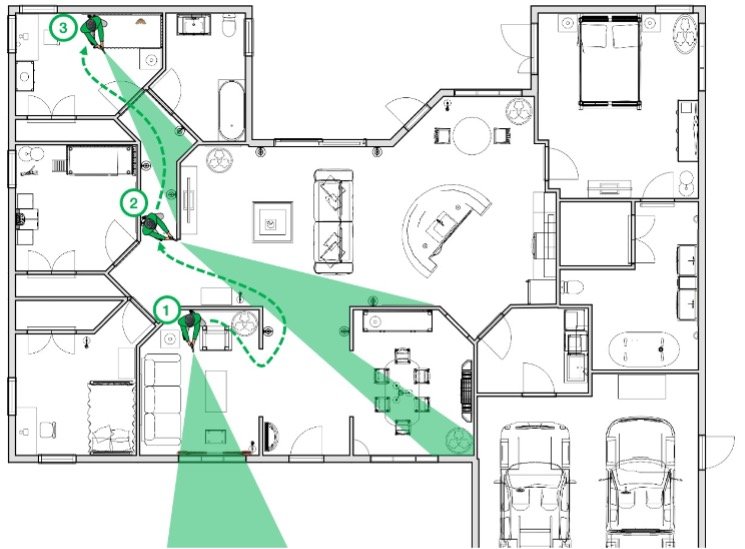
Defensive Angles from Deep in the Room
When you must defend from inside a room, it is often better to position further back in the room than to remain close to the door. By staying back, you can move to the left and right and expose only small slices of the area outside the room at a time, much like the sweep technique, also known as “slice-the-pie” or “threshold evaluation.”
If you position right next to the door and peek around the edge, you will expose yourself to much more of the adjacent room at once and you will be easier for intruders to spot. If possible, try to move furniture within the room to offer you some cover as you assume different defensive angles.
The diagram below gives a general example of how you can observe most of the family room, and even some areas beyond, from positions deeper in the master bedroom. Also, take note that while you may be able to see far into adjacent rooms, intruders can still crouch down to hide behind larger objects such as sofas, cabinets or countertops.
If you position right next to the door and peek around the edge, you will expose yourself to much more of the adjacent room at once and you will be easier for intruders to spot. If possible, try to move furniture within the room to offer you some cover as you assume different defensive angles.
The diagram below gives a general example of how you can observe most of the family room, and even some areas beyond, from positions deeper in the master bedroom. Also, take note that while you may be able to see far into adjacent rooms, intruders can still crouch down to hide behind larger objects such as sofas, cabinets or countertops.
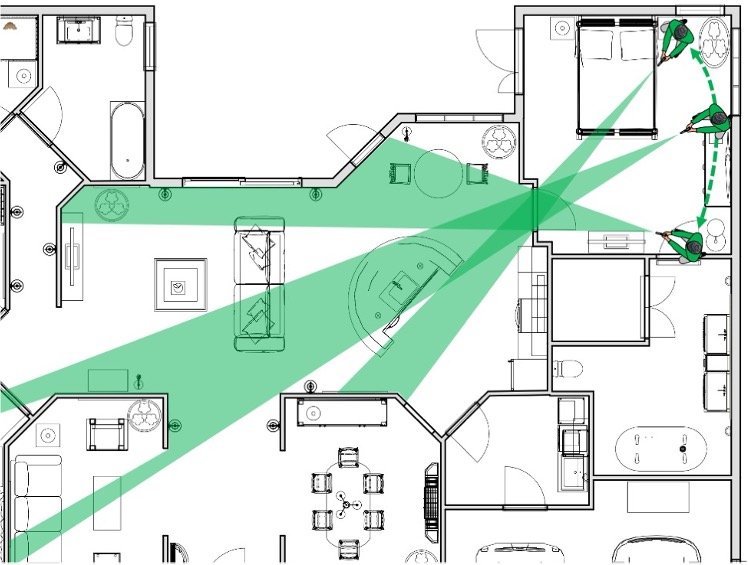
Keep Family Members Out of the Line of Fire
As you develop your defensive plan, it is natural and likely instinctual for you to end up in a position where the attackers are in front of you and your family members (or employees or co-workers) are behind you. While this might seem like a good idea, it is actually quite dangerous because it puts your family in the line of fire.
See the image on the lower left below for an example of this and the inherent risk of such positioning.
In order to reduce this risk, you may have to separate yourself from your family. While it may be a risk to leave your family alone, you must weigh that risk against the risk of drawing hostile fire in the direction of your family.
While it can be effective to engage an intruder at range, if you are close to your family you might unintentionally draw hostile fire, or the intruders themselves, in the direction of your family.
In some cases, it might be better to attempt to draw attention away from your family. Remember that, even if you get into a gun fight with intruders and they shoot you, they may then decide to flee. So even if the intruders somehow kill you, if the rest of your family is hidden somewhere else, your family may still escape the intruders’ attention and survive.
See the image on the lower left below for an example of this and the inherent risk of such positioning.
In order to reduce this risk, you may have to separate yourself from your family. While it may be a risk to leave your family alone, you must weigh that risk against the risk of drawing hostile fire in the direction of your family.
While it can be effective to engage an intruder at range, if you are close to your family you might unintentionally draw hostile fire, or the intruders themselves, in the direction of your family.
In some cases, it might be better to attempt to draw attention away from your family. Remember that, even if you get into a gun fight with intruders and they shoot you, they may then decide to flee. So even if the intruders somehow kill you, if the rest of your family is hidden somewhere else, your family may still escape the intruders’ attention and survive.
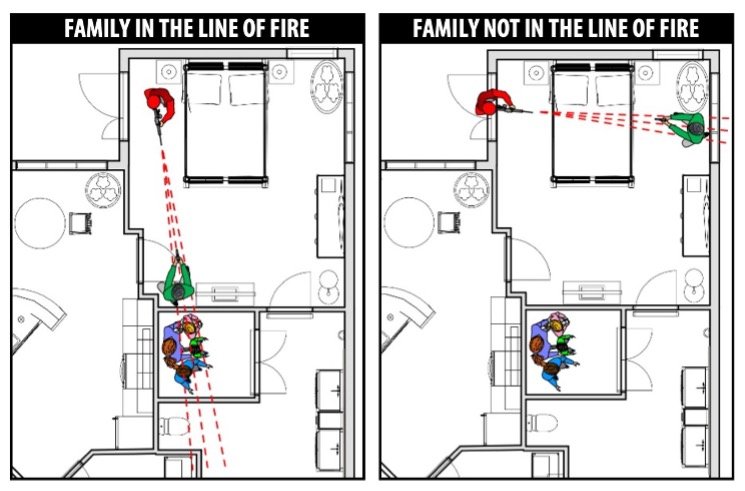
Using Glass Paneled Doors in the Defense
While it might seem that glass paneled doors are less preferable than a more solid wood or even steel door in a defensive situation, they can actually prove extremely useful if you plan to defend your home (or place of business) with a firearm.
First, you should emplace a thin, translucent shade for your glass door or choose a door with frosted glass such as in the photo at the lower right below. This sort of shade or glass will be impossible to see through in some situations but easy to see through in other situations. The key is the lighting around and on either side of the door.
First, turn all lights out on your side of the door and then ensure there is a strong light source further back in the room on the other side of the door. If possible, make the light difficult to turn off or employ a remote control switch that only you can activate.
Next, if you stay far enough back from the door, as a backlit intruder approaches the door you will be able to see him clearly but he will not be able to see you. This silhouetting will make it almost impossible for the intruder to attempt to bypass or break the lock on the door without being seen and getting shot; and, it allows you to see exactly where the intruder is positioned in relation to the door, allowing you to place well aimed fire if necessary.
Incorporating these sorts of shade and light configurations around glass doors in your home or place of business can offer you a critical advantage in a defensive gun fight.
First, you should emplace a thin, translucent shade for your glass door or choose a door with frosted glass such as in the photo at the lower right below. This sort of shade or glass will be impossible to see through in some situations but easy to see through in other situations. The key is the lighting around and on either side of the door.
First, turn all lights out on your side of the door and then ensure there is a strong light source further back in the room on the other side of the door. If possible, make the light difficult to turn off or employ a remote control switch that only you can activate.
Next, if you stay far enough back from the door, as a backlit intruder approaches the door you will be able to see him clearly but he will not be able to see you. This silhouetting will make it almost impossible for the intruder to attempt to bypass or break the lock on the door without being seen and getting shot; and, it allows you to see exactly where the intruder is positioned in relation to the door, allowing you to place well aimed fire if necessary.
Incorporating these sorts of shade and light configurations around glass doors in your home or place of business can offer you a critical advantage in a defensive gun fight.
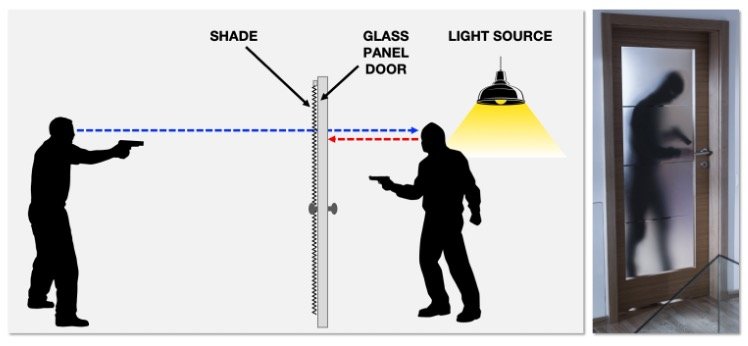
Coming in Upcoming Articles...
Other articles in the Tactical Home Defense article series will cover a wide variety of topics related to the defense of your home and place of business, community defense planning, and more.
©Copyright Special Tactics, LLC. All rights reserved.
Iron Survival, LLC
Featured links
Policy Pages
©Copyright 2026 Iron Survival, LLC
